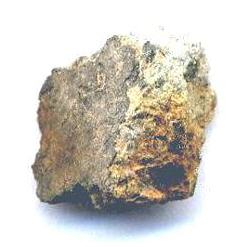DiogeniteDiogenites belong to the evolved achondrite HED group that also includes howardites and eucrites. They are named after the Greek philosopher Diogenes of Apollonia, of the 5th century BCE, who was the first to suggest that meteorites come from outer space (a realization forgotten for over 2,000 years). They are Click on Term to Read More
Harzburgite
(>40 vol% olivineGroup of silicate minerals, (Mg,Fe)2SiO4, with the compositional endpoints of forsterite (Mg2SiO4) and fayalite (Fe2SiO4). Olivine is commonly found in all chondrites within both the matrix and chondrules, achondrites including most primitive achondrites and some evolved achondrites, in pallasites as large yellow-green crystals (brown when terrestrialized), in the silicate portion Click on Term to Read More)

Purchased January 2004
no coordinates recorded Initially, a single, partially fusion-crusted stone weighing 312 g was found in the Northwest Africa desert and purchased through a Moroccan dealer by A. and G. Hupé. The total weight of this material was recorded at 934 g. This meteoriteWork in progress. A solid natural object reaching a planet’s surface from interplanetary space. Solid portion of a meteoroid that survives its fall to Earth, or some other body. Meteorites are classified as stony meteorites, iron meteorites, and stony-iron meteorites. These groups are further divided according to their mineralogy and Click on Term to Read More was designated NWA 1877 and classified at the University of Washington in Seattle (A. Irving and S. Kuehner; see MetBull #88). A second, larger stone, weighing 642.3 g, was subsequently recovered and purchased through a Moroccan dealer by N. Oakes. This mass, designated NWA 2115, was analyzed at Northern Arizona University (T. Bunch and J. Wittke) and determined to be likely paired with NWA 1877 (see MetBull 95). This olivine diogeniteDiogenites belong to the evolved achondrite HED group that also includes howardites and eucrites. They are named after the Greek philosopher Diogenes of Apollonia, of the 5th century BCE, who was the first to suggest that meteorites come from outer space (a realization forgotten for over 2,000 years). They are Click on Term to Read More has been weakly shocked to stage S3 and moderately weathered to grade W2. Additional likely paired fragments have been assigned the names NWA 2286 and NWA 2629 (see MetBull 89).
Northwest Africa 2115 is a yellow-green harzburgitic peridotite composed primarily of
orthopyroxeneOrthorhombic, low-Ca pyroxene common in chondrites. Its compositional range runs from all Mg-rich enstatite, MgSiO3 to Fe-rich ferrosilite, FeSiO3. These end-members form an almost complete solid solution where Mg2+ substitutes for Fe2+ up to about 90 mol. % and Ca substitutes no more than ~5 mol. % (higher Ca2+ contents occur Click on Term to Read More (up to 11 mm) and large phenocrysts of olivine (up to 18.5 mm) within a disrupted, cataclasized
matrixFine grained primary and silicate-rich material in chondrites that surrounds chondrules, refractory inclusions (like CAIs), breccia clasts and other constituents. Click on Term to Read More. Minor amounts of
chromiteBrownish-black oxide of chromium and iron (Cr-Fe oxide), Cr2FeO4, found in many meteorite groups. Click on Term to Read More (mm-sized),
troiliteBrass colored non-magnetic mineral of iron sulfide, FeS, found in a variety of meteorites. Click on Term to Read More, and virtually Ni-free
metalElement that readily forms cations and has metallic bonds; sometimes said to be similar to a cation in a cloud of electrons. The metals are one of the three groups of elements as distinguished by their ionization and bonding properties, along with the metalloids and nonmetals. A diagonal line drawn Click on Term to Read More are present. It contains highly-magnesian silicates similar to those in ALHA77256 and GRA 98108. When found, the NWA 1877/2115/2286/2629 masses constituted the fifth representative of the peridotitic olivine diogenite suite of meteorites, which included NWA 1459, GRA 98108, ALHA77256, and EETA79002. It was proposed that this new group, with members containing at least 5% olivine, be described as olivine
diogenitesDiogenites belong to the evolved achondrite HED group that also includes howardites and eucrites. They are named after the Greek philosopher Diogenes of Apollonia, of the 5th century BCE, who was the first to suggest that meteorites come from outer space (a realization forgotten for over 2,000 years). They are Click on Term to Read More (A. Irving
et al., 2005). Since then, other representative olivine diogenites have been recovered, namely NWA 5405 (~10 vol% olivine), NWA 5312 (24 vol% olivine), NWA 4223 (50 vol% olivine), NWA 5480 (57 vol% olivine), and MIL 07001. While it is hypothesized that olivine diogenites are cumulates constituting distinct layered magmatic intrusions emplaced into the
crustOutermost layer of a differentiated planet, asteroid or moon, usually consisting of silicate rock and extending no more than 10s of km from the surface. The term is also applied to icy bodies, in which case it is composed of ices, frozen gases, and accumulated meteoritic material. On Earth, the Click on Term to Read More, the unusual features exhibited in NWA 5480 suggest a possible origin as a
mantleMain silicate-rich zone within a planet between the crust and metallic core. The mantle accounts for 82% of Earth's volume and is composed of silicate minerals rich in Mg. The temperature of the mantle can be as high as 3,700 °C. Heat generated in the core causes convection currents in Click on Term to Read More residue; however, analyses by Yamaguchi
et al. (2013) led them to conclude that this diogenite is an
impact melt rockRock that has been made temporarily molten as a result of the energy released by the impact of a large colliding body. Impact melts include small particles, known as "impact melt spherules" that are splashed out of the impact crater, and larger pools and sheets of melt that collect in Click on Term to Read More formed at the bottom of a large basin such as Rheasilvia.
An
alternative classification system for the diogenites based on mineralogical and petrographical features has been proposed by Beck and McSween (2010), and modified by Wittke
et al. (2011). In a manner consistent with the IUGS nomenclature, the term harzburgitic diogenite has been proposed to describe the olivine diogenites.
Northwest Africa 2115 contains ~47 vol% olivine with no
plagioclaseAlso referred to as the plagioclase feldspar series. Plagioclase is a common rock-forming series of feldspar minerals containing a continuous solid solution of calcium and sodium: (Na1-x,Cax)(Alx+1,Si1-x)Si2O8 where x = 0 to 1. The Ca-rich end-member is called anorthite (pure anorthite has formula: CaAl2Si2O8) and the Na-rich end-member is albite Click on Term to Read More observed, and it has very Cr-rich chromite. Each of these features suggests that NWA 2115 formed at great depth. The higher olivine abundance observed in some of the other olivine diogenites suggests that they were formed in
strataOriginally horizontal layers of rock. at even greater depth, with the features of NWA 5480 possibly indicating an origin as a mantle residue. However, due to the minor and trace
elementSubstance composed of atoms, each of which has the same atomic number (Z) and chemical properties. The chemical properties of an element are determined by the arrangement of the electrons in the various shells (specified by their quantum number) that surround the nucleus. In a neutral atom, the number of Click on Term to Read More overlaps observed among the diogenite types, they might in fact form a continuum of orthopyroxene accumulation within a fractionated
magma oceanCompletely molten surfaces of terrestrial planets or moons that formed soon after accretion. Samples returned by the Apollo missions provide evidence of a lunar magma ocean, crystallization of which produced a stratified Moon with a low-density crust formed by accumulation of the mineral plagioclase overlying a higher density mantle of Click on Term to Read More or layered intrusion emplaced into the crust. Alternatively, they could represent distinct parental
magmaMolten silicate (rock) beneath the surface of a planetary body or moon. When it reaches the surface, magma is called lava. Click on Term to Read More sources rather than each of the olivine diogenites having an origin in a separate mantle setting (Shearer
et al., 2007; 2010).
The dunitic meteorite
NWA 2968 (>95 vol% olivine) may be the deepest sampled lithology from the HED parent asteroid, widely thought to be 4
VestaThird largest and fourth brightest asteroid; it was discovered in 1807 by Heinrich Olbers and named for the ancient Roman goddess of the hearth. 4 Vesta has a basaltic surface composition and an average density not much less than that of Mars. Evidently lava once flowed here indicating that the and its derivitive Vestoids. Notably, Beck
et al. (2012) identified the first olivine-rich melt material in howardites that constitute the PCA 02009 pairing group. This olivine-rich material was likely derived from harzburgitic and dunitic lithologies exposed on the surface of Vesta. It is envisaged by one investigative team that Vesta and the Vestoids, along with the isotopically similar mesosiderites and IIAB irons, were themselves the products of a breakup of an even larger parent object which they have named ‘Opis’ (Irving
et al., 2009). In Greek mythology, Opis was the wife of Saturn, whose children were Jupiter, Neptune, Pluto, Juno, Ceres, and Vesta.
Further information about this newly recognized group can be found on the
NWA 1459 page. The 1.11 g specimen of NWA 2115 shown above is from the 642.3 g
main massLargest fragment of a meteorite, typically at the time of recovery. Meteorites are commonly cut, sliced or sometimes broken thus reducing the size of the main mass and the resulting largest specimen is called the "largest known mass". Click on Term to Read More, a photo of which is shown below.

Photo courtesy of N. Oakes—Meteorites–R–Us








